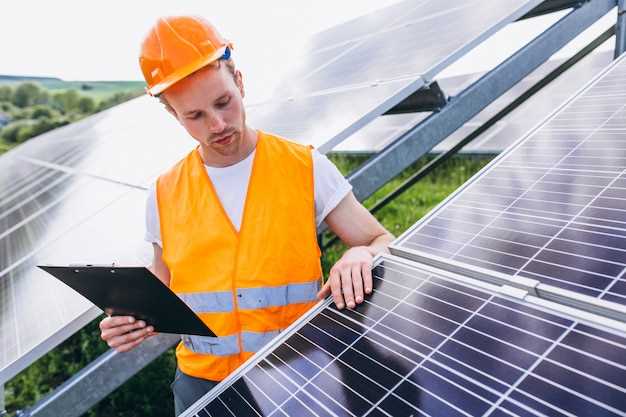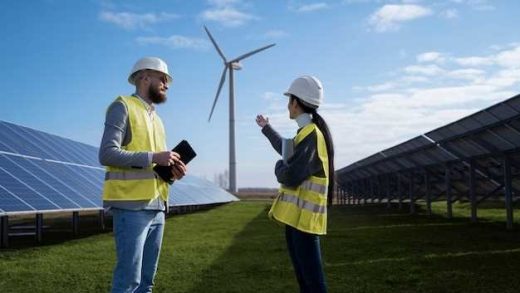
Are you looking for an eco-friendly and cost-effective way to meet your energy needs? Look no further than harnessing the power of the sun. By utilizing an innovative technology, you can generate electricity while reducing your carbon footprint. Whether you are a homeowner or a business owner, solar panel systems offer a sustainable energy solution that can significantly impact your energy usage and reduce your reliance on traditional power sources.
With the increasing demand for sustainable energy alternatives, solar panel installations have become a popular choice for both residential and commercial projects. By installing solar panels on your property, you can tap into the renewable energy of the sun and convert it into usable electricity. This not only decreases your dependence on fossil fuels but also helps to combat climate change by reducing greenhouse gas emissions. Solar panel systems offer a reliable and long-term solution that can benefit both the environment and your pockets.
When considering a solar panel system, it is essential to understand the key factors that contribute to a successful installation. Proper planning, site selection, and system design are critical components that can maximize the efficiency and effectiveness of your solar panel system. By optimizing orientation, tilt, and shading, you can maximize the amount of sunlight your panels receive throughout the day, thus increasing their overall output.
Additionally, understanding the financial incentives and rebates available for solar panel installations can make the venture even more appealing. Many governments and local authorities offer incentives to encourage the adoption of renewable energy sources, making it a financially viable investment for homeowners and businesses alike. By taking advantage of these incentives, you can offset the initial installation costs and start reaping the long-term benefits of solar energy.
Assessing the Energy Needs of Your Property
Understanding the power requirements of your property is crucial when considering the installation of solar panels. By thoroughly assessing your energy needs, you can ensure that the solar panel system you choose is capable of meeting your electricity demands.
Evaluating Power Consumption
Begin by evaluating your power consumption patterns to determine how much electricity your property typically uses. This includes taking into account the various appliances, lighting, and equipment that rely on electricity on a daily basis. By analyzing your power consumption, you can gain valuable insights into your energy usage and identify areas where you could potentially reduce electricity consumption.
Calculating Peak Demand
Calculating your peak demand is essential for understanding the maximum amount of power your property requires at any given time. This is particularly important for commercial properties with fluctuating energy needs throughout the day. By accurately determining the peak demand, you can ensure that your solar panel system is sized appropriately to handle the highest energy demands of your property.
When assessing the energy needs of your property, it’s important to consider future growth and any potential changes in electricity consumption. By taking a comprehensive approach to evaluating your energy requirements, you can make informed decisions regarding the installation of solar panels that will effectively support your property’s energy needs.
Choosing the Right Type and Size of Solar Panels
When embarking on a solar energy project, it is essential to carefully consider the type and size of solar panels that will best suit your specific needs. Selecting the optimal panels is crucial as it directly impacts the efficiency and effectiveness of your solar system. By choosing the right type and size of solar panels, you can maximize energy production and ensure long-term reliability.
Firstly, it is important to determine the type of solar panels that align with your preferences and requirements. There are various options available, such as monocrystalline, polycrystalline, and thin-film panels. Each type has its own set of advantages and disadvantages. Monocrystalline panels, for instance, are known for their high efficiency and sleek appearance. On the other hand, polycrystalline panels are more cost-effective and perform well in lower light conditions. Thin-film panels are flexible and lightweight, making them suitable for certain applications.
Next, you must consider the size of the solar panels. Panel size is typically measured in watts and represents the power output the panels can generate. The appropriate size depends on factors such as available space, energy consumption requirements, and budget constraints. Smaller systems are ideal for residential properties with limited roof space, while larger systems are more suitable for commercial projects with higher energy demands. It is crucial to strike a balance between the desired energy production and the available space to ensure optimal performance.
In addition to type and size, it is recommended to assess the quality and certifications of the solar panels. Look for panels with reputable certifications such as UL, IEC, or TUV to ensure safety, reliability, and compliance with industry standards. High-quality panels tend to have better warranty terms and longer lifespans, providing peace of mind and maximizing the return on investment.
- Consider the specific energy needs and available space
- Evaluate the advantages and disadvantages of different panel types (e.g., monocrystalline, polycrystalline, thin-film)
- Determine the appropriate size of solar panels based on power output requirements
- Ensure the panels have reputable certifications for safety and reliability
By following these guidelines and thoroughly assessing your needs, you can confidently choose the right type and size of solar panels for your residential or commercial solar energy project. Remember, each project has unique considerations, so it is essential to consult with professionals in the field to ensure optimal results.
Finding the Optimal Location for Solar Panel Placement
In order to maximize the efficiency and output of solar panels, it is crucial to carefully determine their placement. Strategic positioning of solar panels plays a significant role in harnessing the maximum amount of sunlight and optimizing energy production. Identifying the ideal location for solar panel placement involves considering various factors and ensuring the panels are exposed to optimal sunlight throughout the day.
Orientation: To make the most of solar energy, it is essential to consider the orientation of the solar panels. Placing the panels in a direction that allows them to capture the most sunlight during peak hours is vital. South-facing placement is generally recommended for maximum exposure to sunlight, although adjustments can be made based on the geographical location and angle of the sun.
Angle: The angle or tilt at which solar panels are installed also affects their performance. The ideal tilt angle depends on the latitude of the installation site. Regions closer to the equator may benefit from a flatter tilt, while those farther away may require a steeper angle to capture the optimal amount of sunlight. Finding the right balance between direct exposure and avoiding partial shading is crucial.
Shading: Shading can significantly reduce the efficiency of solar panels, so it is important to minimize any potential obstructions casting shadows on them. Trees, buildings, or nearby structures should be taken into consideration when determining the placement of the panels. Conducting a shade analysis can help identify potential shading issues and make necessary adjustments to ensure maximum exposure to sunlight.
Weather Conditions: Understanding the local weather patterns is essential when selecting the optimal location for solar panels. Areas with frequent cloud cover or heavy rainfall may require alternative placement strategies. It is crucial to consider the impact of weather conditions, such as fog, snow, or hail, to ensure the longevity and effectiveness of the solar panels.
Clearance and Accessibility: Accessibility for maintenance and cleaning should not be overlooked when choosing the placement of solar panels. Sufficient clearance around the panels allows for easy access, ensuring timely cleaning, inspection, and repairs when necessary. Additionally, considering the accessibility of the site for solar panel installation is crucial during the planning phase.
By taking these key factors into account, it is possible to find the optimal location for solar panel placement, maximizing energy production and the return on investment. Consulting with professionals and conducting a thorough assessment of the installation site can help ensure the long-term success and efficiency of the solar panel system.
Considering the Structural and Electrical Requirements
When embarking on a project that involves the integration of solar technology into your property, it is essential to carefully evaluate the structural and electrical requirements. By understanding these crucial aspects, you can ensure the successful installation and operation of your solar system.
Evaluating Structural Integrity
Before installing solar panels, it is vital to assess the structural integrity of your building or property. This evaluation aims to determine whether the existing structure can support the added weight of solar panels and withstand potential environmental factors such as wind, snow, and seismic activity. Engaging a professional structural engineer is highly recommended to accurately assess the load-bearing capacity and stability of your property.
Exploring Electrical Considerations
Integrating solar panels into your property requires a thorough evaluation of your electrical system. This assessment focuses on ensuring that your electrical infrastructure can handle the increased energy production and efficiently transfer it to power your premises. It involves examining the main electrical panel, distribution circuits, and wiring to identify any potential limitations or upgrades necessary for seamless integration.
- Verify if your electrical panel has sufficient capacity to accommodate the anticipated solar system output.
- Consider the installation of additional circuit breakers or upgrading existing ones to support the increased electrical load.
- Assess the overall condition and suitability of your property’s wiring system to prevent energy losses and ensure optimal performance.
- Consult with a licensed electrician to ensure compliance with local electrical codes and safety standards.
By addressing these structural and electrical requirements before the solar panel installation, you can avoid potential complications and ensure a smooth transition to clean and renewable energy. Remember to consult professionals in the field for expert guidance and adhere to all relevant regulations to maximize the benefits of your solar power system installation.
Hiring a Professional Solar Energy Installation Company
Choosing the right company for your solar energy project is crucial to ensure a successful and efficient installation. When it comes to investing in solar energy, it is essential to seek the services of a professional and experienced installation company. This section will provide you with valuable insights and considerations when hiring a reputable solar energy installation company for your residential or commercial needs.
Experience and Expertise
One of the first factors to consider when hiring a solar energy installation company is their experience and expertise in the industry. Look for a company with a proven track record of successful solar energy projects. An experienced company is more likely to have the necessary knowledge and skills to handle various installation challenges effectively.
Reputation and Reviews
Research the reputation of potential solar energy installation companies by reading reviews and testimonials from previous clients. Online platforms and local directories can provide insights into the experiences others have had with different companies. It is advisable to choose a company with positive feedback and a solid reputation within the industry.
Moreover, consider reaching out to friends, family, and acquaintances who have already installed solar panels. Their personal recommendations can be valuable in finding a reliable and trustworthy solar energy installation company.
Overall, hiring a professional solar energy installation company ensures a seamless process from start to finish. Their experience, expertise, reputation, and positive reviews are all essential factors to consider. By selecting a reputable company, you can have confidence in the quality of workmanship and the long-term performance of your solar energy system.
Maximizing Energy Efficiency and Tax Incentives
Enhancing the efficiency of your energy consumption and taking advantage of tax incentives can significantly contribute to the success of your solar panel project. By optimizing the energy efficiency of your solar panels, you can maximize the financial benefits and reduce the environmental impact of your energy usage. Additionally, understanding and utilizing available tax incentives can further enhance the return on your investment.
Improving Energy Efficiency
There are various steps you can take to improve the energy efficiency of your solar panel system. Firstly, ensuring proper insulation and sealing in your residential or commercial property can prevent energy leaks and reduce the amount of energy required for heating and cooling. Additionally, installing energy-efficient lighting fixtures and appliances can significantly contribute to reducing energy consumption.
Furthermore, regularly maintaining and cleaning your solar panels can optimize their performance and increase energy generation. Regular inspection and cleaning can help remove any dirt, debris, or shading that may reduce the efficiency of the panels. Additionally, monitoring the performance of your solar panels can help identify any potential issues or inefficiencies that need to be addressed.
Taking Advantage of Tax Incentives
Many governments offer tax incentives and rebates for residential and commercial solar panel installations. These incentives are designed to encourage the adoption of renewable energy and reduce dependence on fossil fuels. It is essential to research and understand the specific tax incentives available in your region to maximize the financial benefits of your solar panel project.
| Types of Tax Incentives | Description |
|---|---|
| Income Tax Credits | These credits allow you to deduct a percentage of the solar panel system’s cost directly from your income taxes. |
| Property Tax Exemptions | Some regions offer exemptions on property taxes for residential and commercial properties with installed solar panel systems. |
| Rebates | Rebates provide direct cash payments or reductions in the purchase price of solar panel systems. |
| Solar Renewable Energy Certificates (SRECs) | SRECs represent the environmental benefits of generating solar energy and can be sold or traded to earn additional income. |
It is crucial to consult with a qualified tax professional or advisor to understand the specific requirements and eligibility criteria for these tax incentives. By taking advantage of available incentives, you can significantly reduce the overall cost of your solar panel installation and accelerate your return on investment.


